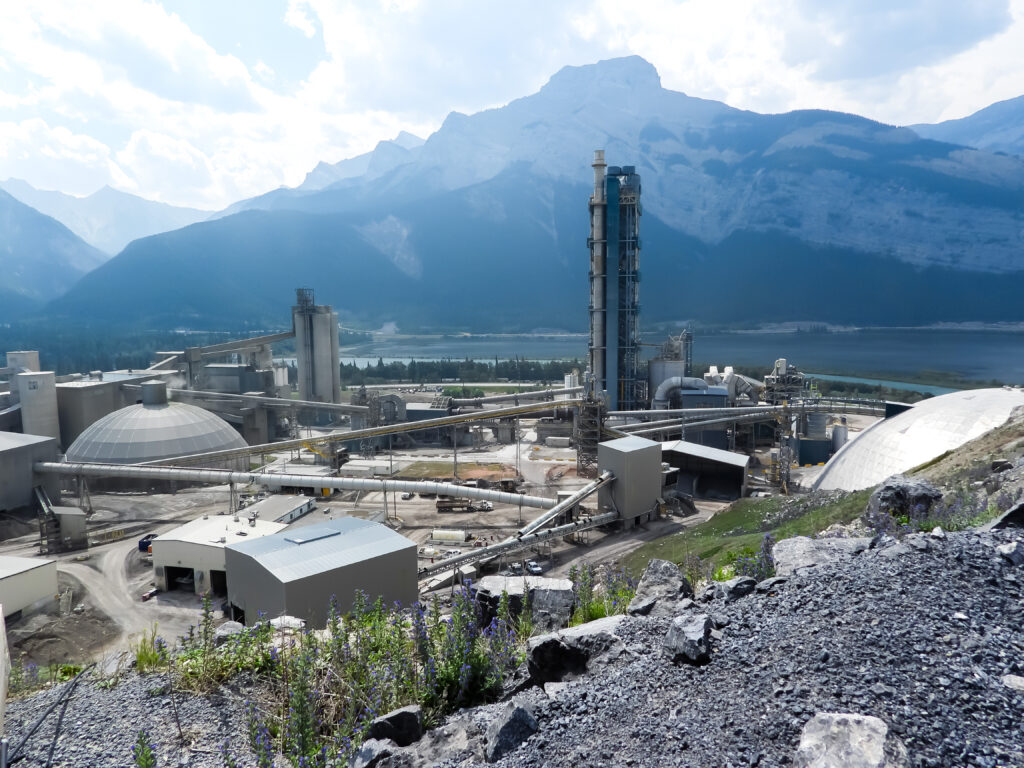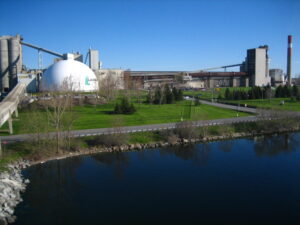
Concrete Gains
By ANDREW SNOOK
Concrete ConstructionCanadian facilities making significant steps toward net-zero targets.
It should come as no surprise that the cement industry is a major contributor to CO2 emissions around the globe. The Cement Association of Canada (CAC) states that the sector is the third-largest industrial energy consumer and the second-largest industrial CO2 emitter, representing approximately seven per cent of the world’s CO2 emissions. The fact that concrete is the second- most consumed commodity around the world, trailing only behind water, amplifies its impact.
To assist the cement industry in its effort to reduce CO2 emissions, in 2022 the CAC, with assistance from Innovation, Science and Economic Development Canada, launched the Roadmap to Net-Zero Carbon Concrete by 2050. The roadmap “commits the sector to achieving reductions of 15 million tonnes of greenhouse gas (GHG) emissions cumulatively by 2030, followed by ongoing reductions of over 4 million tonnes annually from the production of cement and concrete in Canada.”
The CAC expects these GHG reductions to come from a combination of initiatives, including the elimination of the use of coal and petroleum coke, increased use of lower-carbon and alternative fuels, use of alternative and blended cements, improving thermal efficiency, carbon capture investment, the use of clean energy, and advocating for updated codes, standards, specifications and procurement policies.
“Concrete Zero in Canada includes a wide array of different technologies that we can apply today, which, in many cases, are bolt-on technologies that can be implemented right now, with proven effectiveness. In other instances, they’re almost ready for prime time. They’re just in the final stages of demonstration and optimization. And in other cases, it’s really a lot of early-stage research that is in place,” says Robert Cumming, head of sustainability and public affairs for Lafarge Canada (East).
Lafarge Canada, a member of Holcim, is one of the companies that has been leading the charge to lower GHG emissions across the country. Over the past several years, the global building materials manufacturer has been investing millions of dollars in its cement plants across Canada with new technologies, retrofitting them to use alternative fuel supplies.
“Our commitment to sustainability encompasses a multi-faceted approach, revolving around emissions reductions, use of circular economy principles in our products, reduction of our impact on nature and increasing our positive impact on people in communities,” says Stephanie Voysey, head of sustainability and environment for Western Canada at Lafarge Canada. “When we look at it from these four pillars, emissions play a pivotal role. So, over the last 20 years, we’ve looked at investing in upgrading equipment to ensure we have the best available technology. You can see that through the Exshaw revitalization for Kiln 6, which happened in 2016.”
The Lafarge Exshaw Cement Plant in Exshaw, Alta., is equipped with newly modernized kilns that are designed to replace up to 50 per cent of the fossil fuels consumed with lower carbon options. While its kilns are set to use natural gas, they can also be adapted to burn waste-derived fuels.
“On site now, we decommissioned Kiln 4, a long dry kiln. We rely on Kiln 5, a preheater and precalciner, and Kiln 6, an even newer preheater and precalciner. They allow us to produce clinker, which is the main component of cement, in the most efficient way possible,” Voysey explains. “Similarly, for the Richmond [B.C.] plant, the preheater and precalciner were upgraded in 1996. And so, since then, we’ve added a new system of co-processing of alternate fuels in 2018, resulting in a significant reduction of up to 50 per cent in our reliance on fossil fuels.”
Lafarge Canada’s Exshaw and Richmond plants have transitioned from burning coal to natural gas in recent years as part of the company’s sustainability efforts. The Richmond plant completed its transition about four years ago, and now operates using a combination of 50 per cent natural gas and 50 per cent alternate fuels – construction and demolition materials primarily comprised of biomass, wood waste and non-recyclable plastics such as the lids of plastic bottles that cannot be recycled.
“We receive a lot of alternate fuels at the [Richmond] cement plant, which have good heat value. And because we have complete combustion within the alkaline atmosphere in our kilns, we aren’t increasing the emissions out of the kiln. So, there’s waste diversion that’s happening,” Voysey says.
The Richmond cement plant has been able to consistently use 50 per cent alternate fuels over the past year.
“Exshaw has taken a little bit longer on its co-processing journey for alternate fuels; however, we are currently in the construction phase of implementing an alternate fuel system on-site that has a similar goal of reaching 50 per cent in time,” Voysey says.
Lafarge Canada has set a goal of completing this project by early 2024, and Exshaw plans on ramping up its fuel substitution rates, further advancing its sustainability efforts.
CAPTURING CARBON
The remaining 70 per cent of emissions from the Richmond and Exshaw cement plants comes from calcining – the process plants use to heat up the limestone. Those emissions are currently unavoidable unless a viable limestone substitute can be found.
“In response, we’re actively exploring alternative raw materials that we can put into the system, like recycled concrete, to decrease that limestone addition,” says Voysey. “The other way is exploring the potential of CCUS.”
CCUS stands for carbon capture and utilization/storage. The Exshaw plant is reviewing a pre-front end engineering design (FEED) for 1 million tonnes a year of carbon capture from Kiln 6.
“That’s looking at post-combustion removal of 1 million tonnes of CO2 with transportation and sequestration of that CO2 somewhere in the Bow Valley region,” Voysey says.
Working together with proponents in southern Alberta who are looking to create their own sequestration hubs for CO2, as well as the potential for other sequestration hubs that may not have been identified, Lafarge Canada hopes to find something suitable before 2030.
“We’re on track to complete our pre-feed for carbon capture by early 2024, and then Lafarge will evaluate the data available to make an informed decision on proceeding with FEED,” Voysey says. “Exshaw has a really viable case for carbon capture because, in Alberta, the sequestration space is available, and the government is supportive of carbon capture and sequestration geologically onshore.”
DECARBONIZING THE GRID
Lafarge Canada’s operations in Eastern Canada don’t have the same geological formations and regulatory structures of Alberta, so the company is identifying other options for reducing emissions in that province, Cumming explains. One of the ways the company is reducing its emissions is by taking advantage of the largely decarbonized grids in Quebec and Ontario.
“We’re in good shape from a carbon intensity perspective. So, we’re capitalizing on that advantage. We’re implementing several initiatives including pilots with hybrid loaders in our quarries and installing about 100 EV car chargers on sites across Canada to make it easier for our employees to adopt electric vehicles,” he says.
THE CIRCULAR ECONOMY
Other product lines within Lafarge Canada, such as ready mix concrete, aggregates and asphalt, are another big part of the company’s circular economy.
“In our aggregates group, we offer a recycled aggregate product, which is 100 per cent recycled concrete. In certain regions of Western Canada, it can have asphalt mixed into it, and many times, it’s used as a road base,” says Voysey. “And so throughout many of the projects in construction, it’s increasing in use, and that’s a target of ours – to decrease the virgin aggregates that we use and to tap into the stockpiles that we have on our sites, which often come from previous projects, thus promoting sustainable resource utilization.”
One of the challenges with getting recycled aggregates and asphalt used more prevalently is resistance from specifiers.
“It might surprise you and others to hear that many projects don’t like to reuse recycled aggregates, and it’s because virgin aggregates are still readily available. So, we try to educate our customers to ensure they understand that you can use a road base that is recycled aggregates. It doesn’t have to be virgin material,” she says.
Lafarge Canada’s asphalt division also uses Recycled Asphalt Pavement (RAP) on projects whenever possible.
“We do all the testing to achieve 10-, 20-, 30-, or 40-per-cent RAP, tailored to what the municipality is comfortable adding so that it can be reused on the road,” she explains. “For every 10 tonnes of RAP integrated into the asphalt mix, we can reduce one tonne of CO2. This is possible because the old asphalt still has the asphalt cement and aggregates that contribute to the properties of new asphalt, promoting sustainability in road construction.”
Even still, it can be a struggle to get specifiers on board with recycled materials, so the company also educates the industry.
“In collaboration with the Zero Waste Committee in Metro Vancouver, and with the City of Richmond, we’ve developed a RAP protocol, so that municipal engineers can gain a better understanding of these materials and how they’re tested,” says Voysey.
Cumming says Lafarge Canada can achieve a 20 to 40 per cent carbon intensity reduction in concrete delivered. This, he says, coupled with energy efficiency improvements and other actions that are in the planning stages right now, will allow the company to meet its 2030 emissions targets in Eastern Canada.






